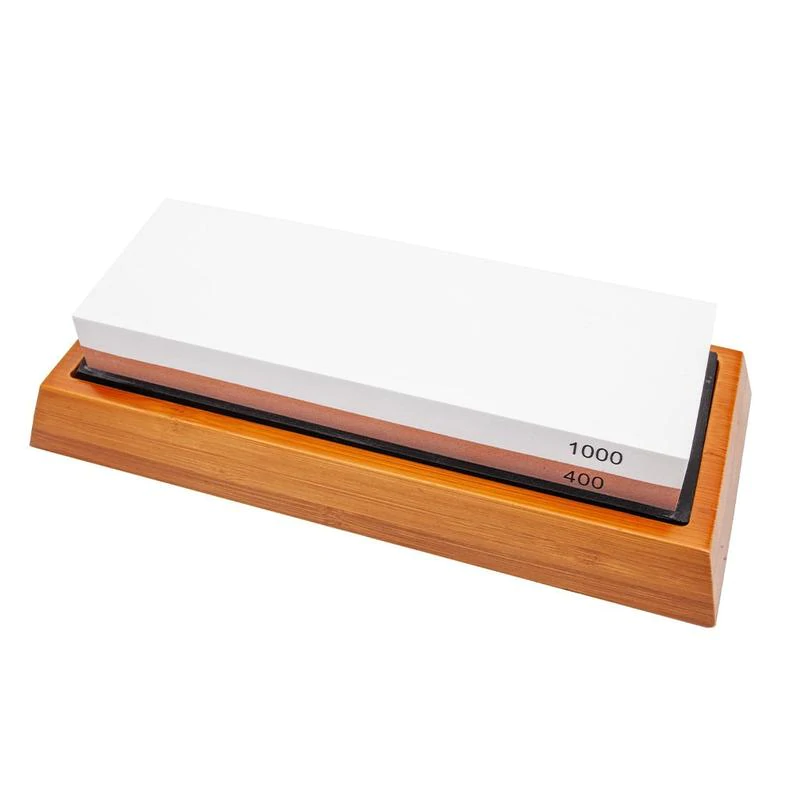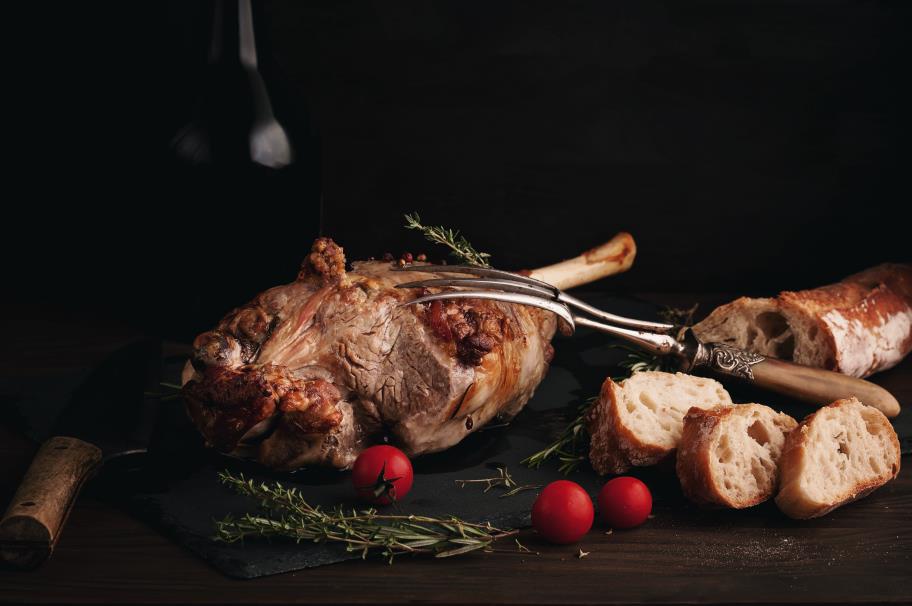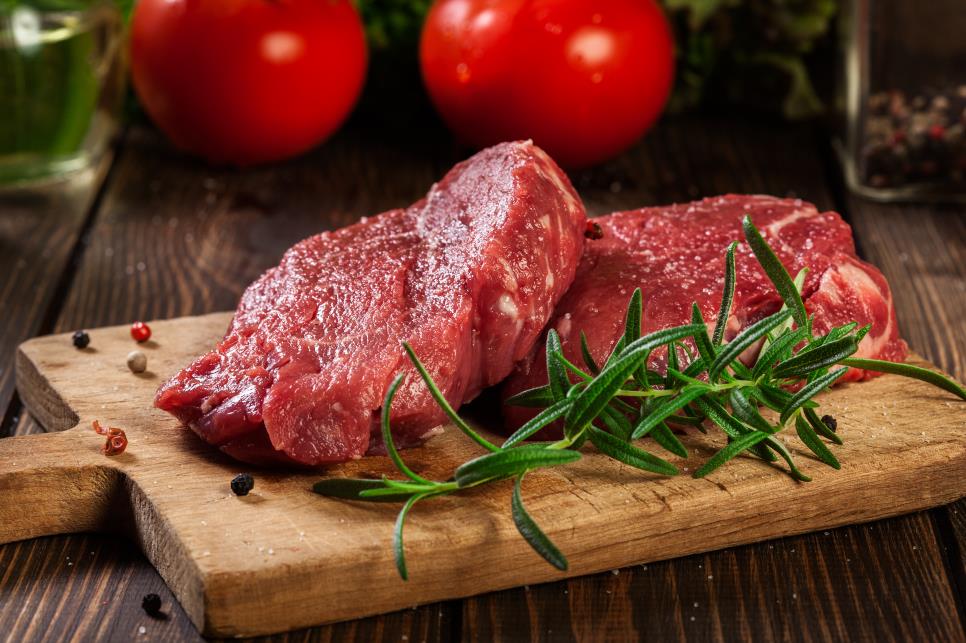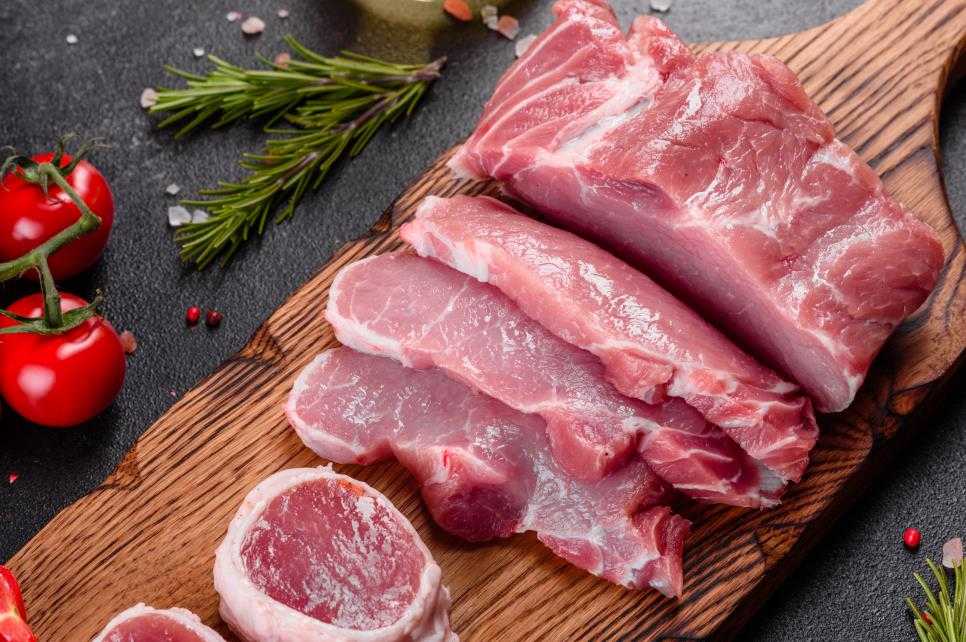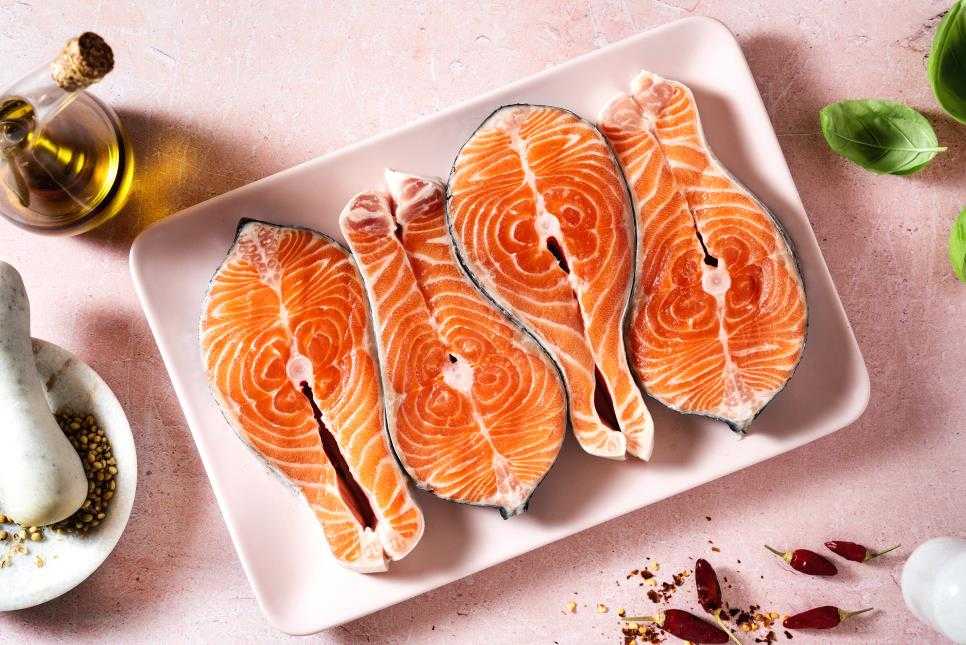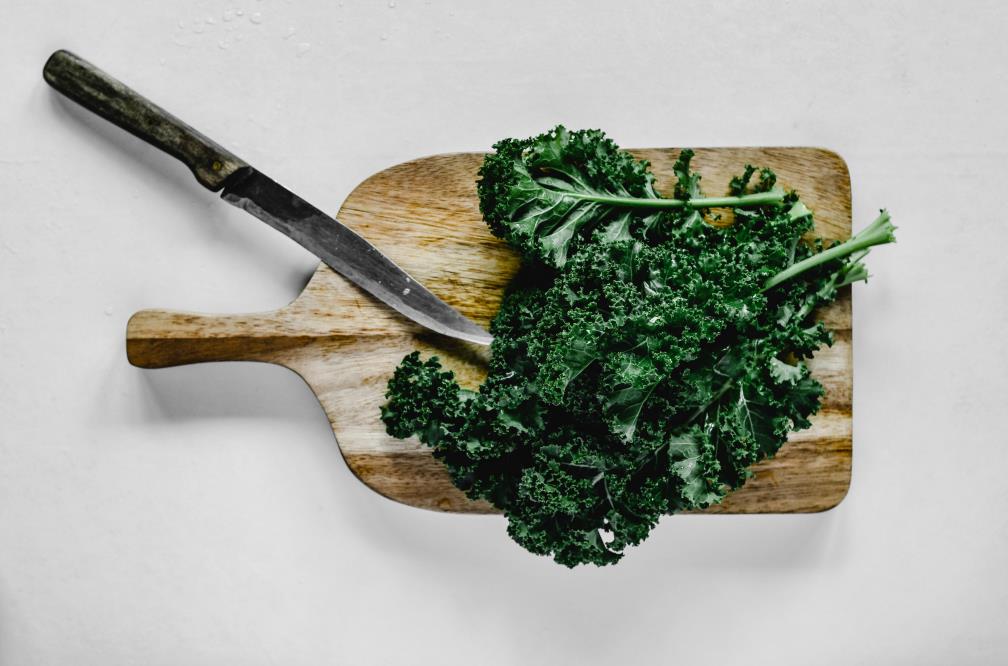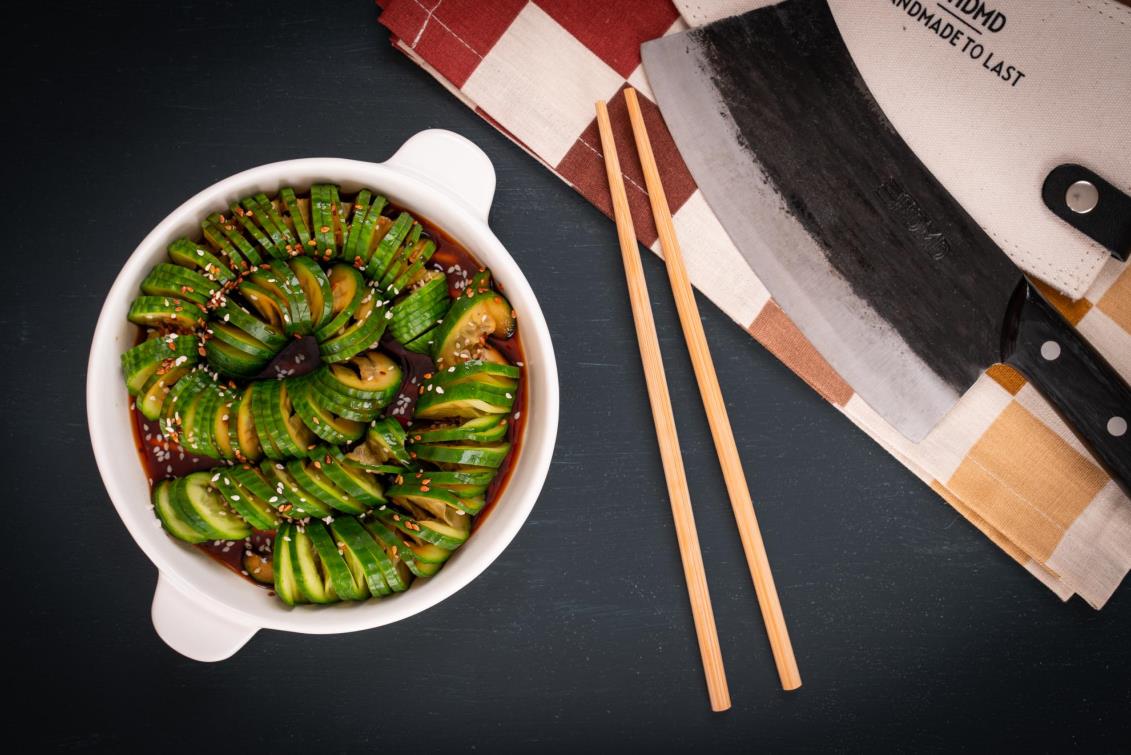Anyone who uses knives knows that knife sharpening is an essential step of knife care. A knife’s cutting performance decreases with time as its edges wear down. Understanding knife sharpening techniques is critical not only for knife safety but for knife performance as well.
To safely and adequately sharpen knife edges, one must have the proper sharpening tools. Always choose a technique you are comfortable with, whether you use knife sharpening stones or knife sharpeners. Once you adapt to a specific knife sharpening method, you can hone the knife edges until they are razor-sharp.
This knife sharpening guide will take you through everything you need to know. This includes selecting the best knife sharpening tools, proper knife maintenance, knife sharpening techniques, knife-edge angles, and more.
Table of contents
Why should you sharpen the kitchen knife?
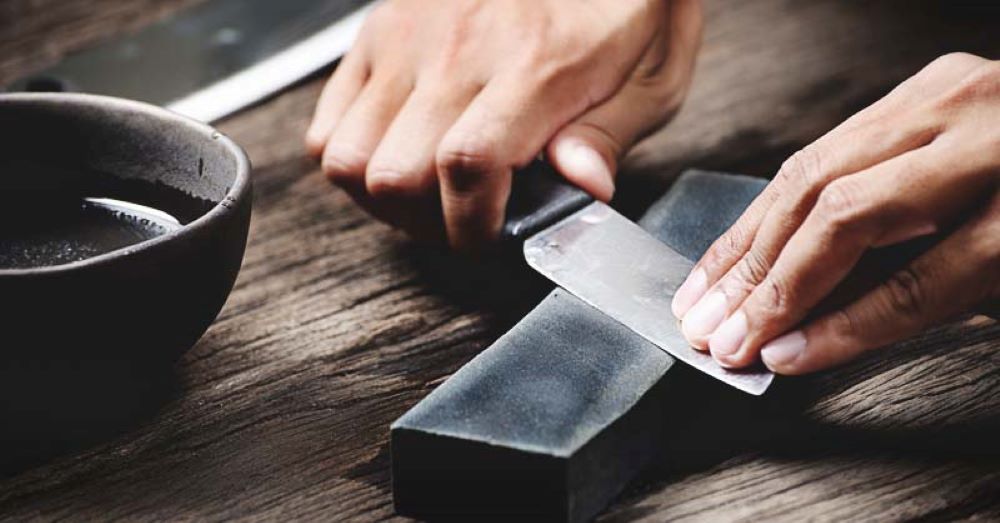
A knife’s edge is the knife’s sharpest part, so keeping it in good shape ensures your knife does its intended job effectively. Yet, knife edges wear down over time. If you don’t sharpen the edges regularly, knife performance decreases, safety becomes compromised, and the knife edges start to chip and damage.
Most chefs will tell you that knife sharpening is knife care’s single most important step. A knife’s edge that chips or rolls takes more time to sharpen back into shape than knife edges that are in good condition. Constant knife sharpening increases efficiency, reduces time wastage, and knife care costs. It also improves knife safety and performance.
As part of your knife care routine, most chefs recommend that you sharpen your knife after every 1-2 months. However, this depends on how often you use your knife, what you are cutting, and other knife-specific variables. The general rule of thumb, however, is that you should professionally sharpen your knife every 6-12 months.
Does sharpening a knife reduce its lifespan?
Conventional knife wisdom suggests that knife sharpening reduces a knife’s lifespan. In a basic sense, knife sharpening involves removing metal from the knife blade, reducing knife material. The more knife sharpening you do, the sooner you’ll need to replace your knife.
However, practicing knife sharpening techniques that ensure knife edges are kept in optimal shape ensures your knife performs better, longer. You can extend knife life by practicing proper knife care and knife sharpening techniques.
To prevent knife roll, knife manufacturers make knife blades with hard steel materials. Harder knife steels such as high carbon steel are more durable (can retain an edge longer) than stainless knife steels, but they are also harder to sharpen. When choosing knife steels, you should consider knife sharpening practices that will boost knife performance.
How to choose a whetstone
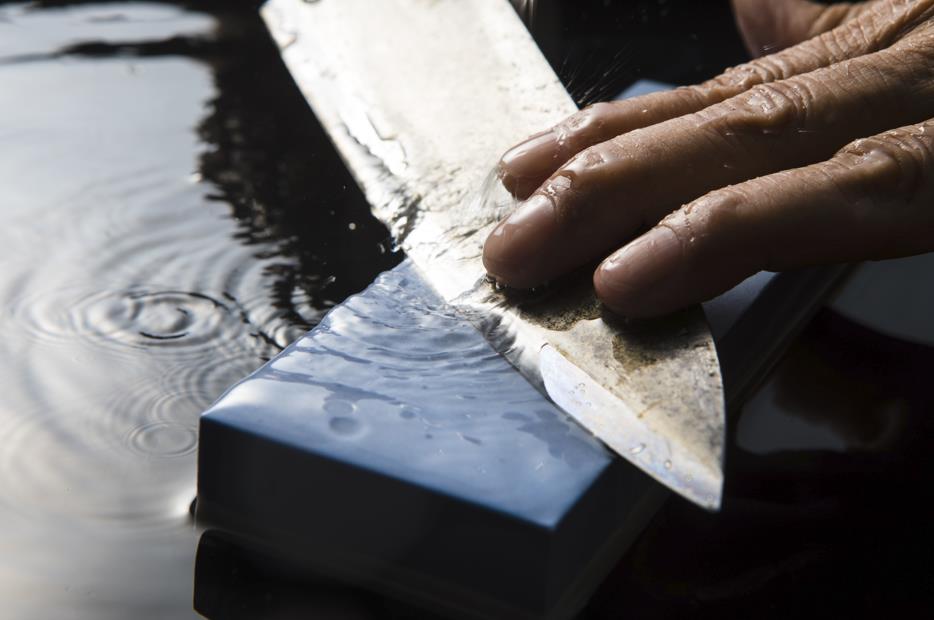
Whetstones are a common knife sharpening equipment for professional cutlers and hobbyists alike. They come in many different grits and coarseness levels, ranging from coarse to extremely fine. Knife sharpening whetstones are either synthetic or natural.
Natural whetstones are quarried from rock deposits, whereas synthetic whetstones feature man made bond abrasive materials that form knife sharpening stones. Depending on your knife design and sharpening practices, you might need a certain grit level of the Whetstone.
The three types of grit levels include:
- Coarse Stone
- Medium Stone
- Fine Stone
Coarse Stone
A coarse stone is one of the most popular knife sharpening stones. Coarse stones have a grit rating of less than 1000 and are best used to repair or sharpen knives with chips or damage. You should not use coarse stones for general knife sharpening. They are more abrasive and may damage knife blades that are in good condition.
Coarse stones are also best for creating knife bevels on blades with an uneven edge angle. The stone helps level out the knife blade spine and reduces knife wear at the cutting edge.
Medium stone
A medium-grit stone is a popular knife sharpening equipment often used for basic knife sharpening. Medium stones come in grit ratings ranging from 1000 to 3000. These knife sharpening stones are helpful for knife blades with minor chips and rolled knife edges.
The ideal medium grit for general knife sharpening is between 2000-3000. Within that range, the coarseness level is finer and won’t damage your knife. Note that knife edges tend to wear out faster when sharpening with whetstones whose grit is below 2000.
Fine stone
A knife sharpening stone with a grit rating greater than 4000 is a fine knife stone. Most chefs refer to this as the finishing stone. You should use knife sharpening stones with a fine grit to polish knife blades after sharpening them with medium or coarse stones. Fine stones also help remove scratches from knife blades.
The recommended grit level for meat cutting is between 4000-6000. However, if you want to cut fruits or vegetables, use a whetstone with an 8000 grit.This is because meat tends to be tougher than vegetables and fruits. Knife blades dull easily when cutting up meat because they’re subject to more wear and tear
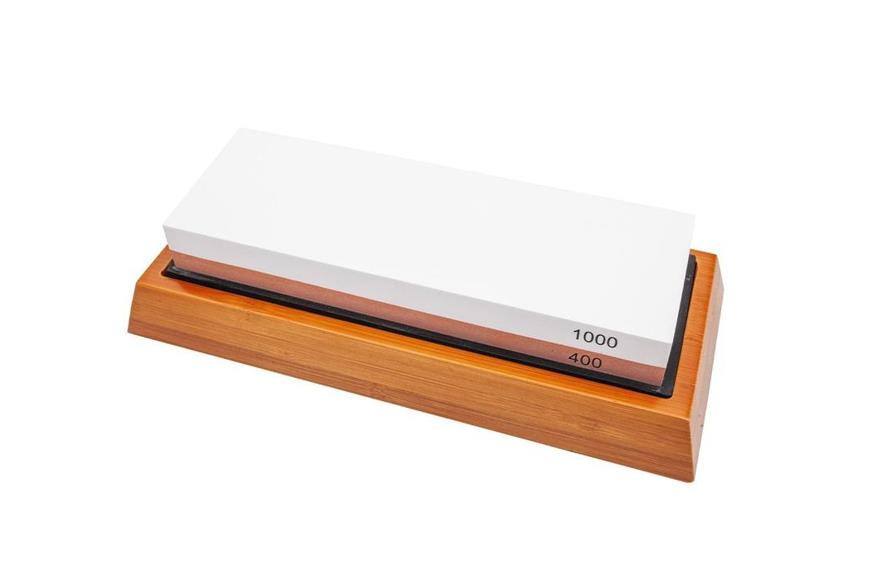
Proper knife sharpening procedure using a whetstone
Finding the proper angle for knife sharpening is critical. For optimum knife sharpening, experts recommend a 22.5-degree angle.
The following steps show how to achieve the ideal knife sharpening angle.
- Ensure you have a sturdy surface to work on and hold the knife in a comfortable knife grip at a 90-degree angle above the whetstone.
- Depending on your hand position, estimate a 45-degree angle and bend the knife blade.
- Repeat the same procedure above, estimate half of the remaining knife angle at 22.5 degrees. This is the knife sharpening angle you should use.
Once you know how to find the knife sharpening angle, it’s time to begin knife sharpening.
The following steps explain the process of knife sharpening in detail.
- Get your setup ready: Place your whetstone on top of a wet towel or a wet rag to prevent it from slipping. Ensure you are operating on a flat surface with enough workspace.
- Wet/Lubricate the stone: Some whetstones require that you wet the stone with water to ensure optimal knife sharpening action. Be sure to check with manufacturer recommendations to determine the lubrication requirements.
- The sharpening action: Place the knife on the blade and determine your 22.5-degree angle. Ensure you have a firm knife hold and slowly but steadily stroke the knife blade across the whetstone. Begin knife sharpening in one direction, away from the knife handle towards the tip of the knife.
- Maintain the knife sharpening angle: Maintain the knife sharpening angle throughout and repeat the above process about five times.
- Repeat for the other side of the blade: If your knife has two bevels, follow steps 3 and 4 above to sharpen the other side of the edge.
- Change the direction: At first, you were sharpening from the handle towards the tip. For this step, you will sharpen the blades in the opposite direction towards the knife handle.
- Fine knife sharpening: Use a fine knife sharpening stone to polish knife blades.
- Clean the knife and stone: Clean knife blades and the knife sharpening stone to remove all metal particles and knife sharpening residue.
Should you use a knife sharpening angle guide?
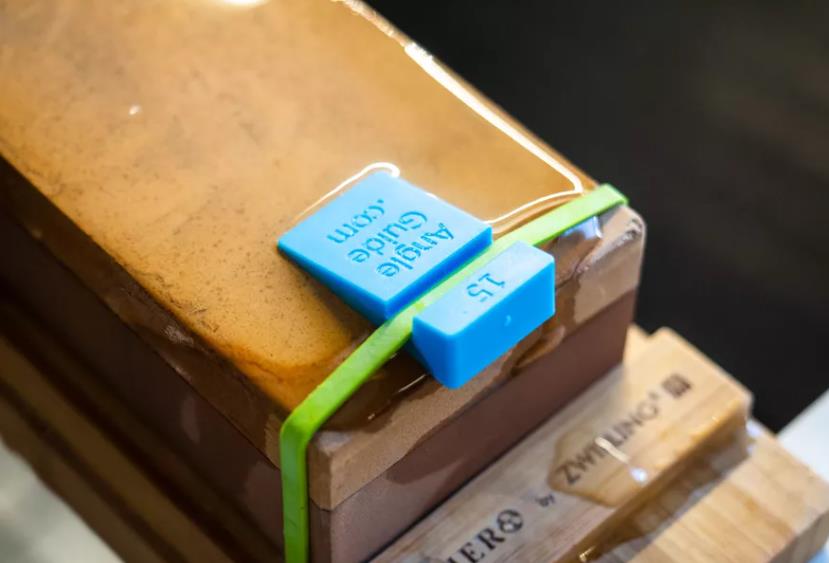
A knife sharpening angle guide is a knife sharpening accessory designed to achieve accurate knife sharpening angles. For instance, if your knife is ground to a 20-degree angle and you want to sharpen it at the same 20 degrees, you will use a 20 degrees knife sharpening angle guide. Also, if you want a much thinner edge, let’s say 15 degrees, you will use a knife sharpening angle guide with a 15-degree angle.
Before we delve further, let’s understand the knife angle concept. Most knives have two bevels, with each knife blade having a primary and secondary bevel. When we say sharpen at an angle of 22.5 degrees, in a basic sense, this means knife sharpening both knife bevels at 22.5 degrees.
Some knives only have a single bevel (mostly traditional Japanese knives). For such, you only sharpen one side of the knife blade at the desired 22.5 degrees. On that note, we can say that the knife angle is the angle orientation to which you position your knife on the stone.
Knife sharpening angle guides ensure that you get knife blades with uniform edges. A knife with consistent edges cuts better and stays sharp longer. In other words, having different knife sharpening angles may result in varied knife blade performance.
Pros and cons of knife sharpening angle guides
Pros
- Easy knife sharpening: Any novice or expert knife sharpener can achieve edges with accurate knife sharpening angles using the knife sharpening angle guides.
- Consistent knife angles: No need to worry about whether knife sharpening angles are accurate. A knife sharpening angle guide will give you knife blades with uniform knife edges.
- Quick setup: Forget the hustle of finding the accurate angle. Position your angle guide on your knife or whetstone (if you are using a wedge), and you are good to go.
Cons
- Limits knife sharpening creativity: If you have a knife with a different knife grinding angle or want to slightly alter the knife sharpening angle for a customizable knife edge, angle guides may not be for you.
- Expensive knife sharpening accessories: You need to purchase knife sharpening angle guide sets, which are slightly expensive. However, you can find great deals in online stores and some knife stores.
The mechanics of a knife sharpener
Apart from whetstones, we have different knife sharpeners with critical features that determine their performance, effectiveness, and ability to give users consistent blade results.
Electric knife sharpeners
Electric knife sharpeners use abrasive disks to grind and hone blades. The electric knife sharpening disks rotate, grinding the blade against them at a specific angle.
It involves a two or three-step process, in which the coarse sharpener first grinds the knife blades to remove the dull old edges. Then, super-fine abrasive disks will hone the blade leaving it polished and sharp.
Handheld sharpeners
As the name implies, handheld knife sharpeners are manual devices that require you to move knives against them to sharpen. They work by drawing the blade across a built-in sharpening surface.
Although most handheld sharpeners don’t yield the same results as whetstones or electric knife sharpeners, they can give your blades a satisfactory sharpness in a short time.
Serrated knife sharpeners
It is impossible to sharpen serrated knives using a regular sharpener. Serrated knife sharpeners have specific slots that allow you to sharpen the teeth of serrated knives at a perfect angle.
The sharpener does not thoroughly grind or hone the blade but re-edges it with its built-in carbide blades. Some handheld sharpeners will have a serrated knife sharpening slot.
Sharpening/Honing steel
A honing/sharpening steel is essential for any knife. It helps you maintain the sharpness of your blades between professional maintenance sessions.
It features a lengthy metal rod that is solid, brittle, relatively narrow, and has no cutting surfaces. The knife steel straightens out the bent knife-edge by cleaning the microscopic teeth along the blade edge.
How to use a sharpener
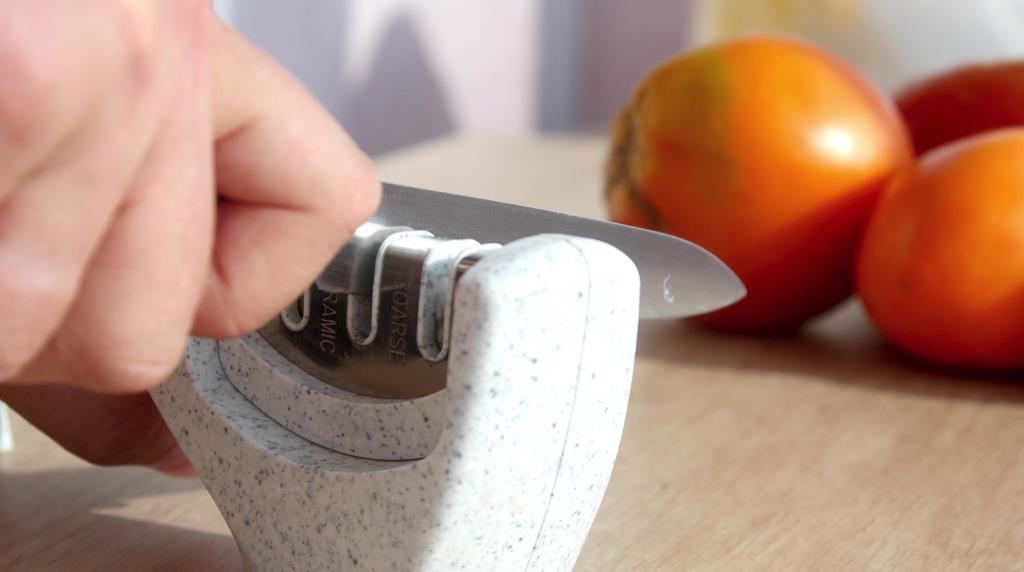
A handheld knife sharpener features two or three stages. Some have more to include serrated knife sharpening slots. Most knife sharpeners feature an abrasive surface that helps you re-edge blades, and others have ridged or coated surfaces.
The following steps will guide you through the knife sharpening process using a sharpener:
- Start with the coarse slot: Place your knife in the coarse slot and pull it from base to tip. Apply even pressure as you repeat the motion five to six times. This will grind metal off your knife to create a new edge.
- Follow the knife contour: As you pull the knife through the sharpener, follow the contour of the blade. This will give you even results all along the blade edge.
- Switch to the medium slot: Place your knife in the medium slot and repeat step one. This time, pull your blade through the slot one or two times.
- Switch to the fine slot: Use this slot as your last stage in the knife sharpening process. Repeat step one, and this time pull the blade through the slot only once twice.
- Clean your knife: Use a damp cloth to wipe your knife clean of any metal particles left behind from the sharpening process.
Whetstone vs. sharpener
Choosing between a whetstone and a sharpener depends on personal preference. They both work pretty well for knife sharpening, and the process is relatively similar.
A whetstone allows you to sharpen your knife safely manually, but it’s time-consuming. The stone may be very coarse or quite fine, depending on how sharp you want your blade.
Using a sharpener is a more straightforward process, but it’s not as precise. The machine does most of the work for you, but your blade isn’t entirely free of burr or metal particles.
A sharpener is handy for someone who doesn’t want to spend too much time on knife sharpening. Whetstones are suitable for people who take the art of knife care passionately.Alternatively, if you are reluctant on investing either sharpening tools, there are DIY guided knife sharpeners out there for you to utilize.
Sharpening Japanese knives vs. western knives
Handpicked for you
True cutting power in the palm of your hand
A Japanese knife is generally thinner, lighter, and harder. It’s ideal for slicing or dicing food into fine pieces. A western knife has a thicker blade with a sturdier build to cut through dense bones or thick vegetables.
Japanese steel knives contain more carbon than western knives. The extra carbon makes them harder and stay sharp longer than the average knife. However, there is a need for regular sharpening because the metal is more vulnerable to corrosion.
Western knives feature softer steel and are not prone to rust. The blades bend and flex, and they don’t corrode as easily as Japanese knives. Regular honing can help maintain the shape of these blades and protect them from damage.
Knife care and maintenance
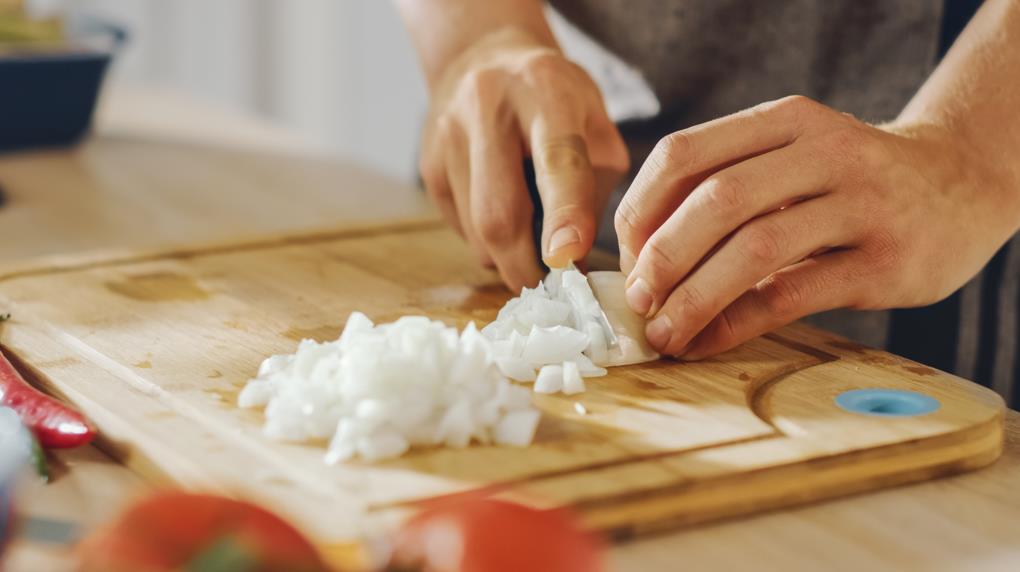
To ensure your knife stays sharp for a long time, follow the basic principles of knife care.
- Rinse and dry your blade immediately after use. Leaving food on the blade can cause it to rust.
- Store your knife in a dry, clean place when it’s not in use. Keep it away from water or other substances that may corrode the steel.
- Sharpen your knife regularly using a whetstone or sharpener. Remember to consider factors such as blade geometry and steel type when choosing a sharpening tool.
- Maintain the sharpness of your knife by honing it regularly. A steel or diamond rod is suitable for this purpose.
- Consider professional tune-up at least once every 6 to 12 months.
FAQs
What do you begin with to sharpen a knife?
The first step of knife sharpening is to inspect your blade for damage. You should also check the orientation of your blade (double-edged, single-edged). Then you should select the proper sharpening tool based on your decision to use a whetstone or sharpener. Begin with the coarse grit or slot if your knife shows signs of heavy damage. If not, you can start with the fine grit or slot to hone your blade.
Do knife sharpening angle guides work?
Knife sharpening angle guides work based on the principles of whetstone sharpening. They make the sharpening process easier. However, you can achieve similar results by holding the blade at a steady angle while sharpening it with a whetstone.
Why is my knife dull after sharpening?
Blades become dull after sharpening due to poor angle control or using the incorrect sharpening method. Another reason is too much pressure when sharpening. You can resolve these issues by using the proper knife sharpening tools and techniques.
Key takeaway
If you own a knife, it’s essential to know how to properly sharpen and care for it. The process shouldn’t be tedious if you use the proper sharpening method and tool. A whetstone or sharpener is effective for knife sharpening, but you need to understand what each type offers.
This guide to knife sharpening should help you make a more informed decision.
Visit our store to find the best knives, sharpeners, and all the accessories you need to keep your blades in excellent condition.

